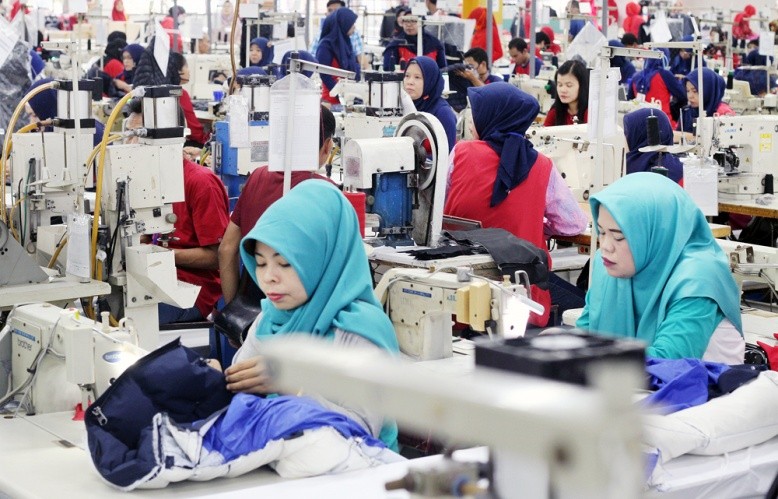As millions of Indonesians adjust to the new reality of work from home and companies struggle to retain their workers in the face of near total shutdown, some industries are bucking the trend. Indonesia is likely to suffer a sharp drop in GDP growth this year but the country is still expected to end the year in positive territory.
World Bank lead economist for Indonesia Frederico Gil Sander noted in a recent teleconference media briefing that while a precise growth forecast was difficult to make, the baseline scenario for Indonesia’s growth was 2.1% in 2020, down from 5.1% initially projected is the situation starts to normalize by June.
“We are looking at the best case scenario where the country only needs mobility restrictions for another month and things can start to normalize by June so the recovery could start in the third quarter,” he said. “The downside risks, however, is the country has severe mobility restrictions even into the third quarter and if there is a deeper global recession, growth will surely move away from the baseline scenario.”
Against this backdrop, the country’s manufacturing sector has been performing relatively well. According to the Central Bureau of Statistics (BPS), total manufacturing exports in the first quarter of 2020 reached US$32.9 billion, growing 10.1% on year on year basis. Its also contributed 78.9% of total US$41.7 billion Indonesia export earnings in Q1 2020.
The agency noted that at least 5 commodities recorded a surge in exports in March. They are iron and steel (up by US$220.9 million), silver ore and metal ash (up by US$53 million), paper and paperboard (up by US$446.9 million), machinery & mechanic tools (up by US$439.6 million) as well as fuel (up by US$35.8 million).
Meanwhile Industry Minister Agung Gumiwang Kartasasmita said that in the first quarter of 2020 there were five sub-sectors that contributed most to export performance, namely F&B that posted US$7.1 billion, basic metal that posted US$5.4 billion, chemical that posted US$2.9 billion, textile that posted US$2 billion as well as rubber & plastic that posted US$1.7 billion.
“We see a shift from CPO (crude palm oil) and its derivative products as well as textile driven exports into iron steel, metal, paper and machinery equipment driven export this year, especially in March. We noticed that increasing export of iron steel is driven by new facility in Morowali Industrial Estate, especially for the Chinese market,” he said.
Silmy Karim, Chairperson of The Indonesian Iron and Steel Industry Association (IISIA) as well as President Director of Krakatau Steel said the industry’s positive result was contributed by stable demand as well as the relaxation of the gas price for industries. Gas is one of biggest cost component in production, accounting for 25% of total production cost. The Government recently lowered the gas price by 30% effectively from US$9 per mmbtu into US$6 per mmbtu, a move that reduced overall production costs by between 3% to 7.5%.
“For us, the production cost will be reduced by 7% until 17%. I also believe our bottom line will finally turn into black this quarter after consecutive losses over the past eight years. Apart from production cost efficiency, the stronger results hugely impacted by the debt restructuring,” Silmy said.
Changing consumer taste
Adhi S Lukma, chairperson of the Indonesian Food and Beverages Association (GAPMMI) as well as President Director of food group PT Niramas Utama (INACO) said that the positive performance of the F&B industry reflected stable consumer demand amid COVID-19 pandemic. F&B industry recorded 10% surge in exports on January, February and March, respectively, since many countries anticipating for the stock during COVID pandemic. Other factors such as new consumers’ preference on plant based protein such as vegetables based burger helped drive demand.
“In some countries like US and Australia, consumers are starting to shift to plant based protein and maybe Indonesia’s consumers will also do the same next year. In the US and Australia for example, there is the new Impossible Burger which is popular among varied consumer segments and is selling very well.
Agroindustry General Director, Ministry of Industry, Abdul Rochim also admitted that during COVID pandemic, the fish canning industry experienced a rise activity in line with growing demand for protein amongst Indonesians during the large scale social distancing (PSBB) imposed by the government. Currently production stock of sardines and mackerel in Indonesia reach 35 million cans. The demand comes primarily from the export market, retail, online platforms as well as for social activities such as donation.
At the moment, there are more than 718 fish canning businesses across Indonesia. This year, export is expected to double from last year to around 1.6 million tons or equal to USS4.1 million. The fish canning industry highly labor intensive, providing jobs for more than 336,000 Indonesian workers.
“This sector is quite resilient and there is no material supply disruption so far. I think we can create more jobs through this industry during this COVID-19 pandemic,” he said.
Indonesia positive manufacture export performance is in line with IMF Report on April,14 titled “The Great Lockdown”. According to the report, while other regions are projected to experience severe slowdowns or outright contractions in economic activity, Emerging Asia is projected to be the only region with a positive growth rate in 2020 (1.0%). Only three economies in the region are forecast to grow at modest rates, including China (1.2%), India (1.9%) and Indonesia (0.5%). Others are forecast to experience large contractions especially Thailand, which will see its economy contract by 6.7%.

